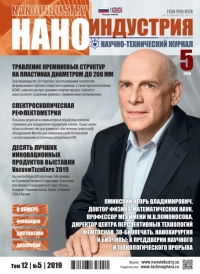Issue #5/2019
V.M.Dolgopolov, V.V.Odinokov, P.A.Irakin, V.M.Varakin
Deep anisotropic silicon etching with high aspect ratio for TSV structures
Process of deep anisotropic silicon etching with alternating steps of etching and passivation process) is widely used for forming three-dimensional structures with through-silicon-vias, as well as in the manufacturing of micro electromechanical systems. The essence of the process lies in alternating steps of reactive-ion etching of silicon (usually SF6) and passivation of the surface (typically by using C4F8). Herewith the step of etching the passivation layer removing from the bottom of the grooves are faster than from the walls, with the result that allows to obtain anisotropic etching process. Advantages of the process include: carrying out the process at room temperatures, high photoresist selectivity (about 80:1 and more), the preparation of structures with an aspect ratio of 30:1, the etch rate up to 20 µm/min and controlled etching profile. The main drawback of the process is the roughness of the walls (scallops) in connection with the cyclical process. The aim of this work was to develop a reactor for deep silicon etching on wafers diameter of up to 200 mm, similar in their characteristics with import and development of technology deep silicon etching for its use in the manufacture of three-dimensional TSV assembly.
DOI: 10.22184/1993-8578.2019.12.5.268.274, УДК: 621.315.592:546.28
Process of deep anisotropic silicon etching with alternating steps of etching and passivation process) is widely used for forming three-dimensional structures with through-silicon-vias, as well as in the manufacturing of micro electromechanical systems. The essence of the process lies in alternating steps of reactive-ion etching of silicon (usually SF6) and passivation of the surface (typically by using C4F8) [1, 2]. Herewith the step of etching the passivation layer removing from the bottom of the grooves are faster than from the walls, with the result that allows to obtain anisotropic etching process. Advantages of the process include: carrying out the process at room temperatures, high photoresist selectivity (about 80 : 1 and more), the preparation of structures with an aspect ratio of 30 : 1 [3], the etch rate up to 20 µm/min and controlled etching profile [4]. The main drawback of the process is the roughness of the walls (scallops) in connection with the cyclical process. The aim of this work was to develop a reactor for deep silicon etching on wafers diameter of up to 200 mm, similar in their characteristics with import and development of technology deep silicon etching for its use in the manufacture of three-dimensional TSV assembly.
Please log in to comment

 rus
rus


